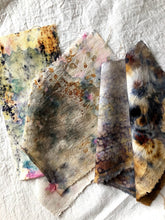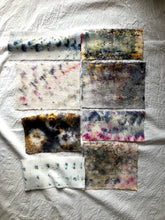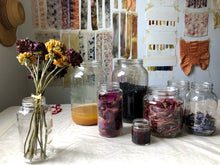DATES: 12/12 & 12/13, SA SU 12-2pm EST both days
WHERE: Zoom (you will receive calendar invitations for each day with Zoom login info)
WORKSHOP: This workshop will introduce you to the basics of dyeing with natural materials. Natural dyes have been used to color textiles and for other artisanal applications for thousands of years. Prior to the industrial revolution that began in the 18th century, all color was derived from natural sources such as plants, minerals, bugs, wood, etc. We are now starting to understand the harmful effects that their replacements, chemical and synthetic dyes, are having on our planet and bodies, and are rediscovering the benefits and beauty of natural color.
We will review the full process - the 3 main steps crucial to achieving saturated, colorfast results - scouring, mordanting & dyeing. We will go over immersion dyeing (extracting a dye bath from raw material) and bundle dyeing (steaming assortment of materials like flower petals). I will be shipping kits out with the dye materials & fabrics materials, but there are some tools you will need to provide - see below!
SET UP, SAFETY & OTHER
-Please wear clothes and shoes you don't mind staining - dyeing can get messy.
-You will need access to water & heat sources (oven or hot plates). I recommend setting up in your kitchen, or outdoor space with hot plates.
-Cover your workspace in plastic drop cloth (floor, table space, etc). Make sure it is taped down and secure so you do not slip! (sometimes I cut & spread open large trash bags and use these to cover my floor)
-I recommend that the kitchen tools you use are not be borrowed from the kitchen if possible, and are dye-dedicated (see below)
YOU WILL NEED TO PROVIDE:
-heat source (oven or hot plates)
-1 or 2 cooking pots (stainless steel highly encouraged & size is at least 2 gallons)
-strainer (stainless steel & one that can rest on top of your pot unassisted- for steaming bundles)
-stainless steel or wooden spoon for stirring
-oven mitts (for handling hot objects)
-plastic drop cloth(s) for covering workspace
-face mask (for when we dissolve mordants)
-tea kettle for boiling water
-measuring spoons (tbsp)
-small stir stick for dissolving materials (chopstick, glass stir stick, cocktail stirrer, metal spoon, etc)
-2 or 3 glass jars (approx 16oz size, or bigger)
-smaller spoons for measuring out dye materials (can use measuring spoons here too)
-2-3 rinse/soak buckets (approx 2 gallon size)
-any kitchen scraps or other items you might want to experiment with (onion skins, beets, berries, veggies, flowers, etc) - please start saving! Food waste can be frozen in a sealed bag/container until you use them, flowers can be dried or used fresh.
-scissors
-optional: mortar & pestle for grinding dye materials into smaller/finer pieces (if you'd like!)
***If you don't have something on this list, email me and we can either improvise, or I can direct you where to purchase.
KIT INCLUDES (THIS IS WHAT I WILL SEND YOU):
-scouring agents (pH neutral soap, soda ash)
-mordants (potash alum, alum acetate - these are aluminum salts)
-dye materials (flower petals, wood chips, roots, dried insect)
-fabrics (silk & cotton)
***If you want to overdye a vintage item or other fabric/fiber you have, you can do that too! I am sending a little extra of the scouring agents & mordants, enough to do something small like a pillowcase or teeshirt.
Natural Dyes 101 - an introduction to the basics of working with natural dyes. We will go over the differences between using cellulose vs protein fibers, scouring, mordanting, immersion dyeing, bundle dyeing, and pH modifiers - everything you need to know to start your own "dye-brary"!





